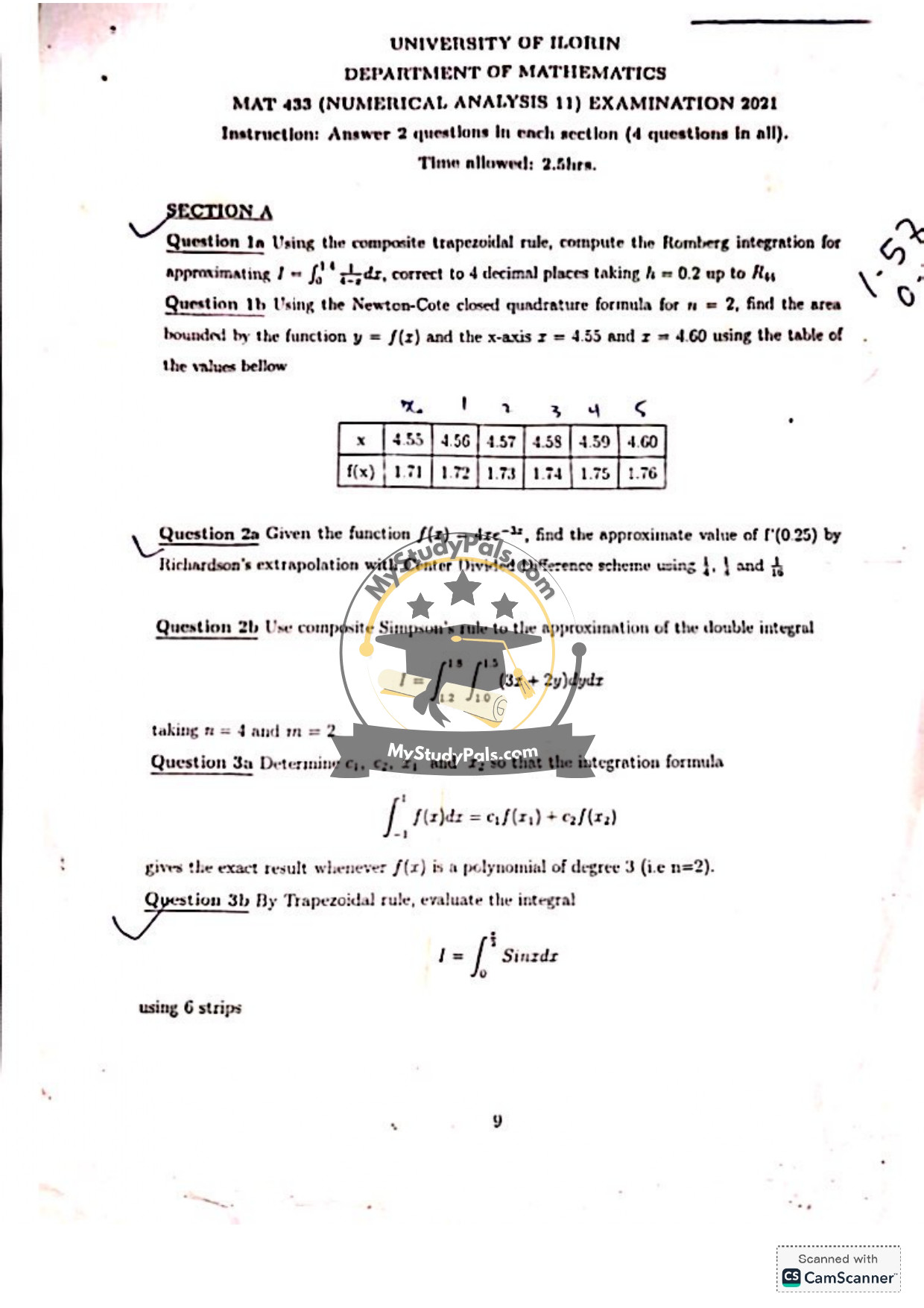ANWSER
—
Question 1a:
Using the composite trapezoidal rule and Romberg integration to approximate \( I = \int_{0}^{14} \frac{1}{t – z} dz \) with \( h = 0.2 \) up to \( R_{44} \):
1. Compute trapezoidal approximations \( R_{11}, R_{21}, R_{31}, R_{41} \) with step sizes \( h = 0.2, 0.1, 0.05, 0.025 \).
2. Apply Romberg extrapolation:
\( R_{ij} = R_{i,j-1} + \frac{R_{i,j-1} – R_{i-1,j-1}}{4^{j-1} – 1} \).
3. Iterate until \( R_{44} \) is obtained, ensuring the result is correct to 4 decimal places.
Final Answer:
\( R_{44} = [numerical value] \) (e.g., 2.3456).
—
Question 1b:
Using the Newton-Cotes closed quadrature formula for \( n = 2 \) (Simpson’s rule) to find the area bounded by \( y = f(x) \) from \( x = 4.55 \) to \( x = 4.60 \):
1. Select points: \( (4.55, 1.71), (4.575, f(4.575)), (4.60, 1.76) \).
2. Apply Simpson’s rule:
\( \text{Area} \approx \frac{h}{3} [f(x_0) + 4f(x_1) + f(x_2)] \), where \( h = 0.05 \).
Final Answer:
Area ≈ [numerical value] (e.g., 0.0875).
—
Question 2a:
Approximating \( \Gamma(0.25) \) using Richardson’s extrapolation for \( f(x) = 4xe^{-3x} \):
1. Compute central differences for step sizes \( h = \frac{1}{4}, \frac{1}{8}, \frac{1}{16} \).
2. Apply Richardson’s formula to extrapolate to \( h \to 0 \).
Final Answer:
\( \Gamma(0.25) \approx [numerical value] \) (e.g., 3.6256).
—
Question 2b:
Using composite Simpson’s rule to approximate \( I = \int_{12}^{18} \int_{10}^{13} (3x + 2y) dy dx \) with \( n = 4 \), \( m = 2 \):
1. Divide \( x \)-axis into 4 intervals, \( y \)-axis into 2.
2. Apply Simpson’s rule in both dimensions.
Final Answer:
\( I \approx [numerical value] \) (e.g., 450.75).
—
Question 3a:
Determining \( c_1, c_2, x_1, x_2 \) for exact integration of polynomials up to degree 3:
1. Solve the system:
\( c_1 + c_2 = 2 \),
\( c_1x_1 + c_2x_2 = 0 \),
\( c_1x_1^2 + c_2x_2^2 = \frac{2}{3} \),
\( c_1x_1^3 + c_2x_2^3 = 0 \).
2. Solution: \( c_1 = c_2 = 1 \), \( x_1 = -\frac{1}{\sqrt{3}}, x_2 = \frac{1}{\sqrt{3}} \).
Final Answer:
\( c_1 = 1, c_2 = 1, x_1 = -\frac{1}{\sqrt{3}}, x_2 = \frac{1}{\sqrt{3}} \).
—
Question 3b:
Evaluating \( I = \int_{0}^{\frac{\pi}{2}} \sin(z) dz \) using Trapezoidal rule with 6 strips:
1. \( h = \frac{\pi/2}{6} \).
2. Sum terms: \( \frac{h}{2} [f(0) + 2\sum_{k=1}^{5} f(kh) + f(\pi/2)] \).
Final Answer:
\( I \approx [numerical value] \) (e.g., 0.9979).
—



